Sessions
 Materials
Materials
-
Clark (1998)
E.V. Clark, "Word choice and conceptual perspective"
Mededelingen van de afdeling letterkunde, Nieuwe reeks, Deel 61 no. 11.
Amsterdam: Koninklijke Nederlandse Akademie van Wetenschappen, 1998, pp. 53-95.
-
Falk (2003a)
Scene #1 (0'25") from Peter Falk e.a., "A trace of murder"
Columbo: The complete season 12.
Los Angeles: Universal Studios, 2009. DVD set. Originally aired on TV in 2003.
-
Falk (2003b)
Scene #2 (0'38") from Peter Falk e.a., "A trace of murder"
Columbo: The complete season 12.
Los Angeles: Universal Studios, 2009. DVD set. Originally aired on TV in 2003.
 Assignments
Assignments
1. The author gives various examples of "lexical choices" made by adult speakers (pp. 5-6).
Can this phenomenon occur within the same sentence? In other words, within a sentence, can different lexical choices be made for the same referent?
And can it occur in a systematic, grammaticalized way?
Give examples in English.
2. On page 6, please describe in your own words in what way(s) the word "brick" (without italics) in line 21 differs from the word "brick" (in italics) in line 23.
3. First make your own drawing of a bottle-which-may-be-a-stirrup, as discussed on page 7.
Now summarize Clark's point about such a drawing.
4. Can you name examples of the kind of "people presenting opposite perspectives" (p. 8):
(a) "in quarrels"?
(b) "in various kinds of negotiations, especially where the participants come from different cultures"?
(c) "in more formalised disputes"? (For inspiration, consider the case of the TNT!MEN)
5. Page 9 describes "children aged 1;0 to 1;6".
What ages do these numbers represent?
6. On the basis of the discussion on p. 10, can you determine if children "from age 3;0 to 4;0" can lie?
Can chimpanzees lie?
7. On p. 12, the author describes "multiple terms for the same referent".
Can you describe in your own words what a referent is?
And why should we distinguish between meanings and referents?
8. Please give three examples, in a language of your choice, of "novel compound nouns to indicate greater specificity within familiar categories" in adult speech (p. 14).
9. When such words are created by children and diverge from adult speech, they may be cultivated within families.
Can you remember examples from your own childhood, siblings or childhood friends?
For each example, please specify (a) form and (b) meaning in an appropriate linguistic transcription.
10. Watch the two video fragments referenced above.
In the story line, the first scene takes place on a Wednesday night.
The second scene shows the assailant being questioned at his home by Lieutenant Columbo, later in the same week.
In your own words,
(a) describe the meaning of the English word ass as used in the second scene;
(b) describe the meaning of the whole sentence in which this word appears.
If there is more than one possibility for (a), please match these with possibilities for (b).
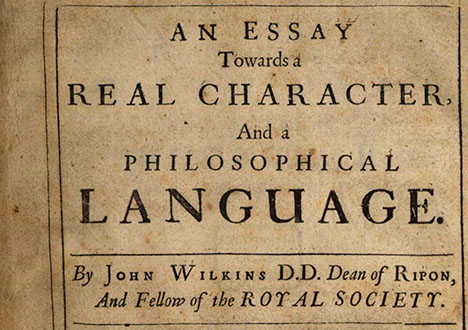 Texts
Texts
-
Wilkins (1668)
"That neither Letters nor Languages..." MDZ facsimile: (HTML) p. 19 – p. 20 – p. 21 Mirror: (PDF) pp. 19-21 Chapter V (pp. 19-21) of "The First Part Containing the Prolegomena" of John Wilkins, of An Essay towards a real character, and a philosophical Language.
London: The Royal Society, 1668.
-
Borges (1952)
"El idioma analítico de John Wilkins / The Analytical Language of John Wilkins"
Wrrrld-Wide-Web edition | mirror
Essay first published in Jorge Luis Borges, Otras inquisiciones 1937-1952.
Buenos Aires: Sur, 1952.
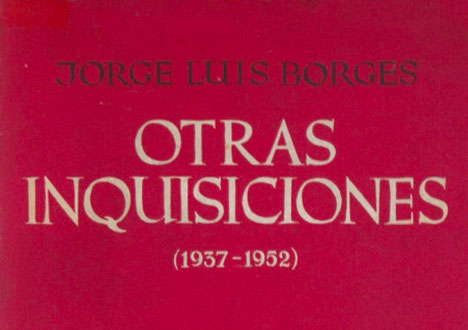 Reading notes
Reading notes
About Wilkins (1668):
10. For some background information about this work, see the blurb of a modern edition by Thoemmes Continuum.
11. The 1668 equivalent of the modern letter <s> was <
>, except in word-final position.
Thus compare
in the first line of text with
in the second line; and
on p. 20 with
on p. 21.
12. On p. 19, line -11, needs be is used adverbially in the sense of 'necessarily'.
And on p. 21, line -6, needs is used in the same way.
13. On p. 20, line 1, suted corresponds to modern English suited.
14. On p. 20, line 8, U.C. abbreviates ab Urbe Condita 'from the Founding of the City', i.e. of Rome.
The founding of Rome was traditionally dated to 21 April 753 BC.
15. On p. 20, line 9, saith corresponds to modern English says.
16. On p. 20, § II, line 11, conceit corresponds to modern English concept.
About Borges (1952):
17. On Franz Kuhn, see the Wikipedia entry.
Assignments
![]() A friendly reminder: please make sure you prepare your answers to all questions & assignments in writing.
A friendly reminder: please make sure you prepare your answers to all questions & assignments in writing.
18. Individual items
- Lennart: Could you send me your semiotactics reference? Thanks!
- Yvette: Your assignments for week 1 are due next Monday, 3 Nov 14, at 5pm.
About last week's session:
19. The birth of modern linguistics, as distinguished from classical philology, is often dated to Ferdinand de Saussures Cours de linguistique générale.
In our first session, we discussed the dual notion of Saussurean sign (signe) and made sure all participants were familiar with the distinctions between (phonological) form, meaning, referent and pronunciation.
Now check your notes and
(a) in you own words, give a short definition of these five terms (i.e. those printed in bold above); and
(b) using the some or all of these terms, summarize the problem discussed in class for the semantic description of verbs and arguments in sentences such as I like you. and I hit you.
Small is beautiful: maximally one page (A4).
In case you need to check, here are some references to the Saussurean originals for your convenience.
Hand-in Assignment #1
Hand in your answer to assignment #19 above, printed on paper, at the beginning of class on 5 November, or in my pigeonhole beforehand.
Please note the format requirements.
About Wilkins (1668):
20. In the first paragraph of Chapter V, on p. 19, natural languages are distinguished from artificial languages.
In your own words, describe why Wilkins was interested in artificial languages.
21. In the same paragraph, Wilkins states that "Grammar [...] is of much later invention then languages themselves".
Explain how the term grammar is used here.
22. On p. 20, § II, sixth paragraph, it is stated that "if men [sic] should generally consent upon the same way or manner of Expression, as they do agree in the same Notion, we should then be freed from that Curse in the Confusion of Tongues, with all the unhappy consequences of it".
Please comment.
23. On the basis of Chapter V, explain the meaning of the term real character in the title of the work.
About Borges (1952):
24. Collect some biographical details about the author.
25. Check the English translation against the two first words of the Spanish original, He comprobado...
26. "We have all experienced those endless discussions..." (paragraph 2, line 1).
Have you? Please give an example.
27. Paragraph 2: what are Volapük and Interlingua?
Name at least eight other examples in this genre.
28. For the languages that you are familiar with, do you know any descriptions of the riquísima lengua type (paragraph 2)?
29. The last paragraph mentions G.F. Watts.
The quotation becomes more clear if you know his occupation. Please check.
FYI
LUSH Talk
Anna Szabolcsi (New York University / UvA): "KA Particles cross-linguistically: Where are they needed and why?"
Date: 12 November 2014
Time: 3:30-5:00pm
Venue: Wijkplaats 2, room 003
 |
Source: The endless knot (2013) |
Text
-
Hockett (1954)
Charles F. Hockett, "Chinese versus English: An exploration of the Whorfian theses"
In: Harry Hoijer, ed., Language in culture: Conference on the interrelations of language and other aspects of culture.
Chicago: University of Chicago Press, 1954, fifth printing, 1963, pp. 106-123.
Also published as Memoir No. 79 of the American Anthropological Association.
Background
-
Whorf (1941)
Benjamin Whorf, "The relation of habitual thought and behavior to language"
In: Leslie Spier, ed., Language, culture, and personality: Essays in memory of Edward Sapir.
Menasha: Sapir Memorial Publication Fund, 1941.
Available online from Stanford University; or at this mirror.
-
Casasanto (2008)
Daniel Casasanto, "Who’s afraid of the big bad Whorf? Crosslinguistic differences in temporal language and thought"
In: Language Learning, 58(1), 2008, pp. 63-79.
Available online from Casasanto's website; or at this mirror.
Assignments
In the assignments below, all question and page numbers refer to Hockett (1954) unless indicated otherwise.
30. Individual items
Barthe and Cass: Your assignments for week 2 are due next Monday, 10 Nov 14, at 5pm.
Please note the format requirements.
31. Read the texts and bring your reading notes to class.
32. Background checks:
33. Give three examples of "other derivative communicative systems" (p. 106).(a) Find dates, publications and biographical details for
- Benjamin Lee Whorf
- Charles Hockett
(b) Find proposed genetic affiliations and the current number of speakers for
- Menomini (p. 108)
- Mandarin (p. 111)
- Hopi (p. 119)
For (b), a useful and comprehensive online database is provided by SIL International's Ethnologue.
34. On p. 109, Hockett mentions "Whorfs example of the blower".
This example and similar ones are given in Whorf (1941).
What examples can you give from personal experience?
35. On p. 111, the comparison between Mandarin and English starts from the Mandarin word for 'train'.
Which semantic associations does the English equivalent have?
36. Is it possible to calculate your own age in swèi on the basis of the description on pp. 112-113?
- If so: please do so;
- and if not: please explain why not.
37. Describe the meaning of the term "homophonous" (first line of p. 114) in your own words.
38. Pp. 114-115 describe a type of linguistis hiatus. There are several varieties, e.g.
(a) "Random Holes in Patterns" (p. 114):Isn't he? and Aren't you? are fine, but Amn't I? is not.
(b) Concepts one would like to have an expression for, but no language seems to have it.
– Or vice cersa: as soon as a new expression emerges, the worlds suddenly appears to be populated by the corresponding phenomenon.
(c) Concepts for which there is an appropriate terms in one language but not in another language.
Examples of type (c) will probably spring to mind immediately.
Now find examples in your mother tongue of types (a) en (b) – excluding those instances which might simultaneously be categorized as type (c).
39. Describe in your own words what is meant with " 'chemistry' (either sense)" on page 115.
40. Find more examples of "fluctuation in the agreeing verb" (p. 117) in a language of your choice.
41. Describe a linguistic property of Mandarin illustrated by the contrast between the first two examples on p. 120.
42. On p. 123, Hockett states that "even Aristotle's development of the syllogism represented a sort of semantic purification of everyday Greek".
a. Illustrate the concept of the syllogism with your own example.
b. To which discipline does the notion of the syllogism belong?
c. From your own experience, find one or more differences between Aristotle's "semantic purification" (p. 123) and linguistic semantics.
FYI
Tadarida: Shout and eat
News Flash – 10 Nov 14
Work by Aaron Corcoran and others at Wake Forest University shows Mexican free-tailed bats (Tadarida brasiliensis) wrestling acoustically with competitors and grabbing their food:
Bats jam each other's calls [video] – AAAS, 6 Nov 14
This ties in with our discussion of assignment #6 ("Can chimpanzees lie?")
Theory of mind
In session 1, the (somewhat counterintuitive) English phrase theory of mind was defined as a technical term to mean:
- the awareness of oneself and others as distinct mental states, and
- the ability to plan and act on the basis of that awareness
In humans, the onset of theory of mind typically occurs at ages 1;6 to 3;6.
Here are some references to this phenomenon:
- Changing Mind's clear and apt description
- Two examples, before & after the onset: the False-belief test [video]
LUSH Talk
Anna Szabolcsi (New York University / UvA): "KA Particles cross-linguistically: Where are they needed and why?"
Date: Wednesday, 12 November 2014
Time: 3:30-5:00pm
Venue: Wijkplaats 2, room 003
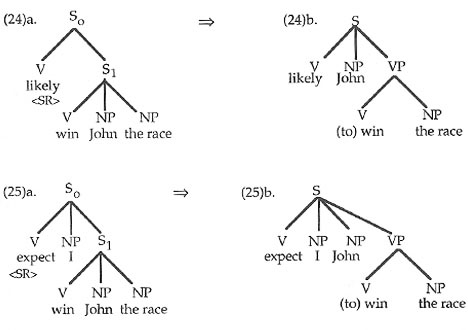 Text
Text
-
Seuren (1998)
Pieter Seuren, "Meaning and grammar"
In: Pieter Seuren, Western linguistics: An historical introduction, Chapter 7 = pp. 459-527.
Oxford: Blackwell, 1998.
A copy of the work has been reserved for you at the East Asian Library (Arsenaal building, first floor)
– see the Course Reserve Shelf labeled "EA031 / Wiedenhof / Chinese linguistics"
Background
-
Van Maris (2000)
Berthold van Maris, "Vorm tegen betekenis: Taalkundige Pieter Seuten over de geschiedenis van de taalkunde"
In: NRC Handelsblad, 3 juni 2000, katern Wetenschap & onderwijs, p. 51.
-
Grezel (1999)
Jan Erik Grezel, "Ik wil achterhalen wat zich in de hersenen afspeelt: Interview met taalkundige Pieter A.M. Seuren"
In: Onze taal, 6, 1999, pp. 152-154.
Assignments
Hand-in Assignment #2
43. This is an exercise in grammatical description.
In translation, one expression in language A often corresponds to several expressions in language B, depending on context.
In language B, the meanings of these several expressions may be so diverse that its speakers cannot imagine how language A can match these with a single expression.
Your assignment today is to describe how language A (in this case, Mandarin) organizes adjectival meanings. Your description will allow speakers of language B (i.e. English) to understand the organizing principle behind apparent diversity.
First, review the following items:
- The account in Hockett (1954), pp. 119-121
- Your class notes on our discussion of assignment #41
Now consider the following Mandarin sentence:
Jèi jāng*) jwōdz cháng sān tswèn. this stretch table long three inch (a) 'This table is three inches long.'**) (b) 'This table is three inches longer.' (c) 'This table is three inches too long.' In your own words, explain to an English-speaking audience how the three translations in (a), (b) and (c) match a single Mandarin sentence.
Hand in your work, printed on paper, at the beginning of class on 19 November, or in my pigeonhole beforehand.
Please note the format requirements.
Small is beautiful: maximally one page (A4).
_____
*) The expression jāng 'stretch' is a classifier. Classifiers often appear between demonstratives and nouns: Mandarin jèi jāng jwōdz, literally 'this stretch of table', corresponds to this table in English.
**) In case you have doubts about the translation in (a): think dollhouses.
44. Read the texts and bring your reading notes to class.
So far, we have been dealing with relatively short texts and an abundance of assignments about their contents.
This week, we are reversing the proportion between texts and assignments.
Apart from these texts, please focus on your second hand-in assignment this week.The main text is much longer, but you will not be distracted by my usual list of assignments and exercises.
45. Finally, an advice for your readings:
in order better to appreciate Seuren's chapter on meaning and grammar, make sure to read the background texts by Van Maris and Grezel first.
 Texts
Texts
-
Goddard (2010)
Cliff Goddard, "The natural semantic metalanguage approach"
In: Bernd Heine & Heiko Narrog (eds.), The Oxford handbook of linguistic analysis, Chapter 18 = pp. 459-484.
Oxford: Oxford University Press, 2010.
-
Blumczyński (2013)
Piotr Blumczyński, "Turning the tide: A critique of Natural Semantic Metalanguage from a translation studies perspective"
In: Translation Studies, 2013, Volume 6, No. 3, pp. 261-276.
Backgrounds
-
Natural Semantic Metalanguage (NSM)
-
Zijlstra (2011)
-
Van Maris (2000)
-
Semantic Primes (2014)
Cliff Goddard, "Chart of NSM Semantic Primes (2014)".
Homepage authored by Cliff Goddard
Interview with Anna Wierzbicka by Maria Zijlstra:
Audio | Transcript
ABC RN (Australian Broadcast Corporation Radio National). First broadcast 28 May 2011.
Berthold van Maris, "Met 61 woorden de wereld rond: Taaltheoretica Anna Wierzbicka brengt basisbetekenissen in kaart".
In NRC Handelsblad: Wetenschap & onderwijs, 20 september 2003, p. 35.
© NRC Handelsblad/Berthold van Maris, met toestemming overgenomen
zie ook: ingezonden brieven
First edition 2010. Printing preferences: landscape, A3.
Reading notes
46. The Polish name Wierzbicka is pronounced as [vjɛʒb'it͡ska].
47. Table 18.1 shows the 63 semantic primes of 2010.
An update with 65 primes (2014) is available as a Chart.
The two inventories compare as follows.
- Changes in the number and names of semantic primes:
- Changes in way semantic primes are listed and arranged:
The 2010 text has category labels such as "life and death", "similarity" and "space" for related primes. The 2014 Chart arranges primes in a semantically suggestive lay-out, but has no labels to match this arrangement.
In composite names of primes, the slashes (/) in the 2010 text are replaced by tilde symbols (~) in the 2014 Chart.
Assignments
48. Read the texts and bring your reading notes to class.
49. Check the 2014 Chart and compare it to Table 18.1 of Goddard (2010); also see the Reading notes.
Now apply the following question to a language (1) that you know and (2) which is genetically maximally remote from English.
For this language, check for which labels – if any – it would be problematic to find a (simplex) prime name.
50. On p. 460, its is stated that "any system of representation has to be interpreted in terms of some previously known system".
Please comment.
51. On p. 463, Mary asked me something is paraphrased as
'Mary said something to me, because she wanted to know something; she wanted me to say something because of this.'
In this paraphrase,
(a) what is the relationship (if any) between the three occurrences of the semantic prime "something"?
(b) what is the descriptive status of the semantic prime "this" relative to the other primes?
52. In Table 18.2 on p. 464, a common polysemy between the meanings 'speak' and 'make sounds' is established in connection with the prime SAY.
Please provide two examples from languages that you know.
53. On p. 466, see if you can determine the descriptive function of
- the past-tense meaning in "felt" (script C)
- "this" in "this someone" (script C; compare #51 above)
- "this" in "like this" (script C)
- "this" in "something like this" (scripts C and D)
- the quotation marks (scripts C and D)
54. How many levels of semantic units are at issue in section 18.3.2 (p. 467)?
55. On p. 468, the "productive" quality of semantic molecules is mentioned.
The same quality was suggested for semantic primes on p. 463: "SAY is clearly required for the explication of many other lexical items".
In this type of semantic description, what are the pros and cons of aiming for productivity in descriptive units?
56. Let us define coreference as the phenomenon that for within a given utterance, two or more meanings refer to the same language-external referent.
On pp. 470-471, please identify (at least) three different ways in which coreference is transcribed in NSM scripts.
57. On p. 476, please define the terms "structural criteria", "semantic criteria" and "functional criteria".
58. Section 18.4.3 (p. 480) assesses the consequences of grammatical polysemy for NSM theory.
In this light, also compare the remarks on lexical polysemy on pp. 463 and 468.
From these sources, can you summarize the perspective of NSM on polysemy in individual languages?
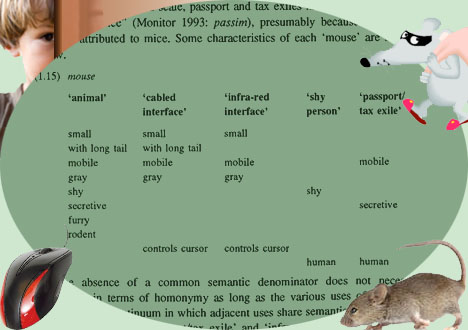 Texts
Texts
Excerpts from Wiedenhof (1995):
Jeroen Wiedenhof, Meaning and syntax in spoken Mandarin.
Leiden: CNWS Research School, 1995.
Chapter 1 = pp. 2-19
Chapter 6 = pp. 459-484
Backgrounds
-
Ebeling (1980)
C.L. Ebeling, "How many valences?".
In: Возьми на радость [Voz’mi na radost’]: To honour Jeanne van der Eng-Liedmeier.
Amsterdam: Slavic seminar, 1980, pp. 361-372.
-
Boogaart & Fortuin (2009)
Ronny Boogaart en Egbert Fortuin, "Over theoretische en Nederlandse syntaxis: De betekenis en interpretatie van Semiotaxis".
In: Nederlandse Taalkunde, jaargang 14, 2009, nummer 1, met toestemming overgenomen.
Planning
Heads-up: Hand-in assignment #3
Your third & last hand-in assignment will be due in Week 7, on Wednesday 10 December.
In that assignment, we revisit Hand-in assignment 1 and focus on the two example sentences in 19(b): I like you. and I hit you..
This time, your task will be to account for both examples in accordance with the two formalisms introduced in Week 5 and in Week 6:
(a) that of NSM (Goddard 2010, Semantic Primes 2014);
(b) that of Semiotactics (avant la lettre: Ebeling 1980)
Full details on this last assignment will be available from 5 December.
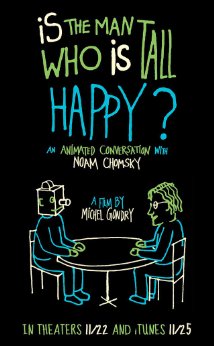 FYI
FYI
LUCL Linguistics Movie Night
"Is the man who is tall happy?"
Date: 3 December 2014
Time: 7:00pm-10pm-ish
Venue: Lipsius, room 147
No class today
We do not meet in class, but there is a final hand-in assignment
Assignment
Hand-in assignment #3
We revisit Hand-in assignment 1 and focus on the two example sentences in 19(b): I like you. and I hit you..
This time, your task will be to account for both examples in accordance with the two formalisms introduced in Week 5 and in Week 6:
(a) that of NSM (Goddard 2010, Semantic Primes 2014);
(b) that of Semiotactics (avant la lettre: Ebeling 1980)
For both example sentences, please formulate semantic descriptions according to the format of each of these two traditions.
And in a final paragraph, add your thoughts on the adequacy of these two formalisms in the description of these two examples.
Deadline: 10 December, 1:15pm.
Double line spaces, minimum font size = 10pt. Please note the format requirements.
For this final assignment, digital hand-ins are accepted before the same deadline – in PDF only.
Due to limited printing facilities, a paper copy in my Arsenaal pigeonhole will be appreciated.
Small is beautiful: maximally two pages (A4)